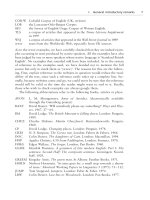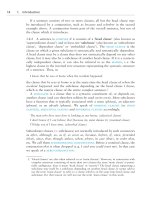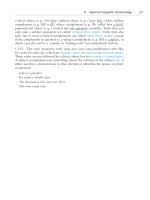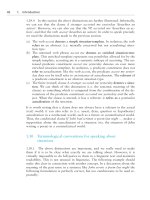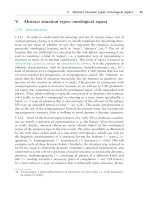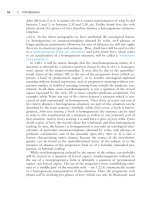The grammar of the english verb phrase part 3 docx
Bạn đang xem bản rút gọn của tài liệu. Xem và tải ngay bản đầy đủ của tài liệu tại đây (67.77 KB, 7 trang )
I. General introductory remarks 7
COB-W Cobuild Corpus of English (UK, written)
LOB the Lancaster-Oslo-Bergen Corpus
SEU the Survey of English Usage Corpus of Written English.
TLS a corpus of articles that appeared in the Times Literary Supplement
in 1997
WSJ a corpus of articles that appeared in the Wall Street Journal in 1989
www texts from the Worldwide Web, especially from UK sources
As to the www-examples, we have carefully checked that they are indeed exam-
ples occurring in texts produced by native speakers. All the examples have also
been judged by one or more speakers whose native language is ‘Standard British
English’. No examples that sounded odd have been included. As to the system
of reference to the examples used, we have decided not to mention the full
source but only to mark them as ‘(www)’. The reasons for this are the follow-
ing. First, explicit reference to the websites in question would reduce the read-
ability of the text, since such a reference easily takes up a complete line. Sec-
ondly, because websites come and go, we could never be sure that the reference
would still be valid at the time the reader might want to surf to it. Finally,
those who wish to check examples can always google them.
The following abbreviations refer to the following books, articles or plays:
AVON L. M. Montgomery. Anne of Avonlea. (electronically available
through the Gutenberg project)
BAXT David Baxter. ‘Will somebody please say something?’ Plays and Play-
ers. 1967. 27Ϫ64.
BM David Lodge. The British Museum is falling down. London: Penguin.
1989.
CHUZ Charles Dickens. Martin Chuzzlewit. Harmondsworth: Penguin.
1969.
CP David Lodge. Changing places. London: Penguin. 1978.
CRES N. F. Simpson. The Cresta run. London: Fabers & Fabers. 1966.
DOC Colin Dexter. The daughters of Cain. London: Macmillan. 1994.
FFFP Agatha Christie, 4.50 from Paddington, London: Fontana. 1970.
FORG Edgar Wallace. The forger. London: Pan Books. 1960.
GLME Hendrik Poutsma. A grammar of late modern English. Part I: The
sentence. Second Half: The composite sentence. Groningen: Noord-
hoff. 1929.
GREEM Kingsley Amis. The green man. St Albans: Panther Books. 1971.
HORN Norbert Hornstein. ‘As time goes by: a small step towards a theory
of tense.’ Montreal Working Papers in Linguistics 5 (1975): 73Ϫ112.
JUMP Tom Stoppard. Jumpers. London: Faber & Faber. 1972.
LBW Colin Dexter. Last bus to Woodstock. London: Pan Books. 1977.
8 1. Introduction
LOD Ruth Rendell. Lake of darkness. London: Arrow Books. 1981.
LSW Colin Dexter. Last seen wearing. London: Pan Books. 1977.
MAR Frank Marcus. ‘Mrs. Mouse are you within?’ Plays and Players, July
1968. 29Ϫ40.
NICH Peter Nichols. A day in the death of Joe Egg. London: Faber & Faber.
1967.
NMDT Ruth Rendell. No more dying then. London: Arrow Books. 1971.
OSIN P. D. James. Original sin. London: Faber & Faber. 1994.
PIN David Pinner. Dickon. Harmondsworth: Penguin. 1967.
SCRLT N. Hawthorne. The scarlet letter. (electronically available through the
Gutenberg project)
SOA Colin Dexter. The secret of annexe 3. London: Pan Books. 1987.
TCIE Eva Edgren. Temporal clauses in English. Uppsala: Almqvist & Wik-
sell. 1971.
TOCC Doris Lessing. This was the old chief’s country. London: Triad
Grafton. 1951.
TSM Ruth Rendell. Talking to strange men. London: Arrow Books. 1987.
TTR Franz Kafka. The Trial. Translated by Willa and Edwin Muir. Har-
mondsworth: Penguin. 1971.
WTBS Joe Orton. What the butler saw. London: Methuen. 1971.
As far as the spoken corpus examples are concerned, sometimes very minor
alterations have been made in the interests of easier intelligibility. These include
the insertion of commas, some suppression of hesitation signals such as er, and
‘correction’ of small production errors where the intended utterance is obvious,
such as the amendment of you’ll only buy able to buy to you’ll only be able
to buy.
1.4 The structure of the book
The book falls roughly into three parts: chapters 1 and 2 provide essential
background to the study of tense; chapters 3 to 11 gradually build up a picture
of the function of tenses in discourse in English; finally, chapters 12 to 14
provide a more detailed analysis of some of the interactions between tenses and
time adverbials in English. Below we give a thumbnail sketch of the contents of
each chapter.
In Chapter 1 we define our basic terms and explain those concepts and
distinctions that underlie our description of the function of tense in English
discourse. We provide definitions of basic linguistic terms such as ‘verb phrase’
or ‘situation’ as we will use them, and give a brief overview of the three main
areas of grammaticalized verbal meaning which interact with one another,
I. General introductory remarks 9
namely tense, mood / modality and aspect. We go on to explain our view of
what sorts of things can be denoted or referred to by a verb, a verb phrase, a
clause or an utterance. Finally we explain the concepts associated with what is
traditionally considered to be lexical aspect (for example the contrast between
a ‘state verb’ and a ‘dynamic verb’) and introduce the category of ‘actualization
aspect’ (which contrasts with both grammatical aspect and lexical aspect and
involves a single contrast, viz. that between boundedness and nonbounded-
ness).
Chapter 2 lays the foundation proper of our description of tense in English.
There is a brief discussion of what is meant by ‘tense’, with reference to the
main issues surrounding the number and nature of tenses in English (for exam-
ple, the question of whether English has a future tense). We introduce those
concepts necessary to describe the way in which tenses are used to locate situa-
tions in time relative to speech time and to each other, for example the concept
of ‘situation time’, and the concept of ‘orientation time’ (or ‘time of orienta-
tion’) Ϫ roughly speaking, a ‘known’ time to which a situation time can be
related by a tense. The elements of the framework of the tense theory used in
this book are outlined here. These include, centrally, the notions of ‘time
spheres’, ‘time zones’, and ‘temporal domains’. Time spheres and time zones
have to do with the way in which tenses in English divide up time. The concept
of temporal domain accounts for the way in which temporal relations between
situation times are expressed by tenses, or not, as the case may be. (See chap-
ter 8).
Chapters 3 to 7 deal with the meaning and use of the four ‘absolute’
tenses Ϫ roughly speaking, those tenses which relate the time of a situation
directly to speech time. Chapters 3 to 5 address, respectively, the present tense,
the past tense and the present perfect, and Chapter 6 examines some of the
differences between the past tense and the present perfect. In Chapter 7 we
take a look at the fourth absolute tense, the future tense, and also at other
verb forms that can locate a situation time in the future.
In Chapter 8, we fill in the detail of the theoretical framework on which
our description of tense rests. This framework distinguishes between temporal
location as it is represented by tenses, temporal location expressed by temporal
adverbials and pragmatically implied temporal location. Time as it is repre-
sented by tenses is divided into two time-spheres Ϫ past and present Ϫ and
four time zones Ϫ past, pre-present, present and post-present. The framework
that we propose shows how the four absolute tenses mentioned above establish
temporal domains in one of those time zones and how these domains can or
cannot (depending on the time zone in question) be ‘expanded’ by the use of
‘relative’ (or in some cases ‘pseudo-absolute’) tenses which relate one situation
time to another, rather than to speech time. The final part of Chapter 8 con-
siders some of the interpretive strategies that regulate interpretation of tempo-
10 1. Introduction
ral relations when clauses with absolute tenses follow one another and there is
no linguistic indication of the temporal relation between them. Specifically, it
considers the way in which the (non)boundedness of the situations concerned
guides interpretation of the temporal relationships between them.
Chapter 9 looks in more detail at the different sets of relative tenses used
to expand a temporal domain, according to whether the domain is centred in
the past time zone, the pre-present time zone, the present time zone, or the
post-present time zone.
Chapter 10 takes a closer look at the use of tenses to locate situation times
in the future, or, to be more precise, in a temporal domain which is centred in
the post-present zone. The set of tenses which can be used to establish post-
present temporal domains, but which do not relate situations to one another,
make up the ‘Absolute Future System’. These include not only the future tense
but also certain other forms, such as the future perfect or the simple present
when it refers to scheduled future events (e. g. The train arrives at six). How-
ever, when a temporal domain is centred in the post-present, there is another
set of tenses which relate situation times either to the central situation time of
the domain or to one another. This set of tenses makes up the ‘Pseudo-t
0
-
System’, so-called because the central time of the domain is treated as a
‘pseudo-t
0
’ (roughly, a pseudo-speech-time). Thus, in He will arrive when you
are in London, will arrive is a tense form from the Absolute Future System
(which establishes a post-present temporal domain) whereas are is a tense form
from the Pseudo-t
0
-System (which expresses simultaneity within the post-pres-
ent temporal domain in question.) The two systems have different distribu-
tions, and the chapter is devoted to a description of the contexts in which each
system is either possible, obligatory or excluded.
In Chapter 11, the notion of ‘temporal focus’ is introduced. This concerns
cases in which it is possible to choose between two or more tenses to represent
the temporal location of the same situation, depending on whether the tempo-
ral focus is on one (represented) time or another. (For example, we may say
We moved to Brighton because it was by the sea or We moved to Brighton
because it is by the sea). The choice may be between two (or more) tenses
which locate the situation in different time zones or it may be between tenses
which locate it within the same time zone. We discuss what difference the
choice of temporal focus may make to the interpretation of the discourse.
Chapters 12 to 14, as mentioned above, deal with the interaction of tempo-
ral adverbials and the tense of the clause in which the adverbial functions.
Chapter 12 explores further the topic which was addressed in chapter 6, viz.
the contrast between the past tense and the present perfect when they establish
domains in the past zone and the pre-present zone, respectively. The two tenses
differ in their co-occurrence with certain types of time adverbial. The relevant
categories of time adverbial are described, followed by a discussion of their co-
I. General introductory remarks 11
occurrence with the past tense and the present perfect. Chapters 13 and 14
look at the semantics of the temporal adverbs when, before and after and the
consequences of these semantics both for the adverbial clauses they introduce
and for the temporal relationship between the adverbial clause situation and
the head clause situation.
12 1. Introduction
II. General linguistic terminology
1.5 ‘Situation’, ‘actualization’, ‘actualize’
We will use situation as a cover term for the various possible types of contents
of clauses, i. e. as a cover term for anything that can be expressed in a clause,
namely an action, an event, a process or a state (see 1.42). Unless it is necessary
to distinguish between these possibilities, we will speak of ‘the situation re-
ferred to’.
1
The verb actualize will be similarly used as a cover term for the
predicates that are typically associated with one of these situation types. Thus,
when it is irrelevant whether a clause refers to the performance of an action,
the happening of an event, the development of a process or the existence of a
state, we can say that the clause in question refers to the
actualization of a
situation. In this way it is easier for us to make generalizations about clauses
and their reference to situations.
It is important to note that actualize will be used as an intransitive verb
(similar to happen). This is a deviation from the normal use of the word, which
is mostly used as a transitive verb. Thus, we will say that John is building a
house expresses that the situation of John building a house ‘is actualizing’
(rather than that the situation ‘is being actualized’). We adopt this convention
because we need a verb that functions in a parallel way to ‘happen’ but without
the implication that the situation is always an event (rather than a state, action
or process). A sentence referring to a state (e. g. Bill is clever) also represents
a situation as actualizing.
1.6 Phrase
A prototypical phrase is a group of words forming a unit and consisting of a
head or ‘nucleus’ together with other words or word groups clustering around
it. If the head of the phrase is a noun, we speak of a
noun phrase (NP) (e. g.
all those beautiful houses built in the sixties). If the head is a verb, the phrase
is a verb phrase (VP). In the following sentence the VP is in italics and the
verb head is underlined:
Jill prepared us a couple of sandwiches.
A phrase is only potentially complex. In other words, the term is also used to
refer to ‘one-word phrases’, i. e. nonprototypical phrases that consist of a head
only. Thus the sentence Jill smokes is a combination of a noun phrase and a
verb phrase.
1. There are several other terms that are similarly used as cover-terms in the linguistic
literature: ‘event’, ‘state of affairs’, ‘eventuality’, ‘process’.
II. General linguistic terminology 13
1.7 Clause, predicate
Leaving aside nonfinite clauses (i. e. infinitival, participial and gerundival
clauses), a prototypical
clause is a combination of a ‘subject’ Ϫ typically a
noun phrase Ϫ and a ‘predicate’. The predicate Ϫ sometimes called
predicate
constituent
to distinguish it from ‘verb phrase’ Ϫ minimally contains the
verb phrase. Thus, in Jill prepared us a couple of sandwiches, the VP prepared
us a couple of sandwiches functions as ‘predicate’, as does smokes in Jill
smokes.The
predicate of a clause can be roughly defined as ‘what is said (or
asked) about the subject’. In other words, the predicate constituent comprises
all the constituents of a clause except the subject. A clause, then, is a linguistic
unit made up of, minimally, a noun phrase and a verb phrase. In this basic
clause, the noun phrase functions as subject (and thus, for example, in English
controls the feature of number on the verb) and the verb phrase (VP) functions
as predicate. However, the predicate constituent may contain other elements
in addition to the VP. These constituents Ϫ usually prepositional phrases or
adverbial phrases Ϫ express optional rather than necessary information (see
below). Thus, in Tim killed three spiders last night, the adverbial last night
belongs to the predicate constituent but not to the VP, unless it gives important
new information. Out of context, the sentence can be paraphrased ‘Tim killed
three spiders. He did so last night.’
1.8 Sentence
1.8.1 A sentence is a linguistic unit that can be used as an independent
utterance. It is a clause or a combination of clauses that does not function as
a constituent of a larger syntactic construction and can therefore be fully ana-
lysed syntactically without reference to what precedes or follows. In speech, a
sentence is normally delimited by pauses and marked by a falling or rising tone
at the end. The following examples illustrate this definition:
Bill hasn’t arrived yet. (pronounced with falling tone)
[Because it was getting late] she wondered whether her son hadn’t missed the train.
(pronounced with falling tone at the end)
What did you say you wanted? (pronounced with rising tone)
Although the prototypical sentence is made up of one or more clauses, which
means it prototypically contains one or more verb phrases, verbless utterances
are often treated as ‘verbless sentences’. Since this book is entirely devoted to
tense, which is a grammatical category that can only be expressed by verb
forms, verbless utterances like Good evening, Much ado about nothing, Yes,
What a shame!, etc., will be disregarded.

